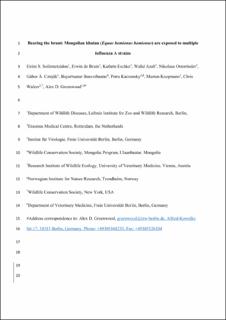| dc.contributor.author | Soilemetzidou, Eirini S. | |
| dc.contributor.author | de Bruin, Erwin | |
| dc.contributor.author | Eschke, Kathrin | |
| dc.contributor.author | Azab, Walid | |
| dc.contributor.author | Osterrieder, Nikolaus | |
| dc.contributor.author | Czirják, Gábor Á. | |
| dc.contributor.author | Buuveibaatar, Bayarbaatar | |
| dc.contributor.author | Kaczensky, Petra | |
| dc.contributor.author | Koopmans, Marion | |
| dc.contributor.author | Walzer, Chris | |
| dc.contributor.author | Greenwood, Alex D. | |
| dc.coverage.spatial | Mongolia | en_US |
| dc.date.accessioned | 2021-01-25T10:39:08Z | |
| dc.date.available | 2021-01-25T10:39:08Z | |
| dc.date.created | 2020-03-05T10:10:19Z | |
| dc.date.issued | 2020 | |
| dc.identifier.citation | Veterinary Microbiology. 2020, 242 1-5. | en_US |
| dc.identifier.issn | 0378-1135 | |
| dc.identifier.uri | https://hdl.handle.net/11250/2724496 | |
| dc.description.abstract | The majority of influenza A virus strains are hosted in nature by avian species in the orders of Anseriformes and Charadriformes. A minority of strains have been able to cross species boundaries and establish themselves in novel non-avian hosts. Influenza viruses of horses, donkeys, and mules represent such successful events of avian to mammal influenza virus adaptation. Mongolia has over 3 million domestic horses and is home to two wild equids, the Asiatic wild ass or khulan (Equus hemionus hemionus), and Przewalski’s horse (Equus ferus przewalskii). Domestic and wild equids are sympatric across most of their range in Mongolia. Epizootic influenza A virus outbreaks among Mongolian domestic horses have been frequently recorded. However, the exposure, circulation and relation to domestic horse influenza A virus outbreaks among wild equids is unknown. We evaluated serum samples of Asiatic wild asses in Mongolia for antibodies against influenza A viruses, using modified protein microarray technique. We detected antibodies against hemagglutinin (H) H1, H3, H5, H7, H8 and H10 influenza A viruses. Asiatic wild asses may represent a previously unidentified influenza A virus reservoir in an ecosystem shared with populations of domestic horses in which influenza strains circulate. | en_US |
| dc.language.iso | eng | en_US |
| dc.rights | Attribution-NonCommercial-NoDerivatives 4.0 Internasjonal | * |
| dc.rights.uri | http://creativecommons.org/licenses/by-nc-nd/4.0/deed.no | * |
| dc.subject | Influenza A | en_US |
| dc.subject | virus | en_US |
| dc.subject | serology | en_US |
| dc.subject | Asiatic Wild Asses | en_US |
| dc.subject | exposure | en_US |
| dc.subject | antibodies | en_US |
| dc.title | Bearing the brunt: Mongolian khulan (Equus hemionus hemionus) are exposed to multiple influenza A strains | en_US |
| dc.type | Peer reviewed | en_US |
| dc.type | Journal article | en_US |
| dc.description.version | acceptedVersion | en_US |
| dc.subject.nsi | VDP::Klinisk veterinærmedisinske fag: 950 | en_US |
| dc.subject.nsi | VDP::Clinical veterinary sciences: 950 | en_US |
| dc.source.pagenumber | 1-5 | en_US |
| dc.source.volume | 242 | en_US |
| dc.source.journal | Veterinary Microbiology | en_US |
| dc.identifier.doi | 10.1016/j.vetmic.2020.108605 | |
| dc.identifier.cristin | 1799758 | |
| dc.relation.project | Norges forskningsråd: 251112 | en_US |
| dc.relation.project | Andre: Leibniz Gemeinschaft (SAW-2015-IZW-1 440). | en_US |
| cristin.ispublished | true | |
| cristin.fulltext | postprint | |
| cristin.qualitycode | 2 | |

